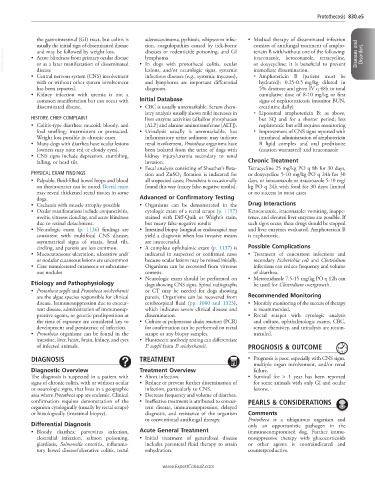Page 1652 - Cote clinical veterinary advisor dogs and cats 4th
P. 1652
Protothecosis 830.e5
the gastrointestinal (GI) tract, but colitis is adenocarcinoma, pythiosis, whipworm infec- • Medical therapy of disseminated infection
usually the initial sign of disseminated disease tion, coagulopathies caused by tick-borne consists of antifungal treatment of ampho-
VetBooks.ir • Acute blindness from primary ocular disease • In dogs with protothecal colitis, ocular itraconazole, ketoconazole, tetracycline, Diseases and Disorders
tericin B with/without one of the following:
and may be followed by weight loss.
diseases or rodenticide poisoning, and GI
lymphoma
or as a later manifestation of disseminated
or doxycycline; it is beneficial to prevent
disease
○ Amphotericin B (patient must be
• Central nervous system (CNS) involvement lesions, and/or neurologic signs, systemic immediate dissemination.
infectious diseases (e.g., systemic mycoses),
with or without other system involvement and lymphoma are important differential hydrated): 0.25-0.5 mg/kg diluted in
has been reported. diagnoses. 5% dextrose and given IV q 48h to total
• Kidney infection with uremia is not a cumulative dose of 8-10 mg/kg or first
common manifestation but can occur with Initial Database signs of nephrotoxicosis (monitor BUN,
disseminated disease. • CBC is usually unremarkable. Serum chem- creatinine daily)
istry analysis usually shows mild increases in ○ Liposomal amphotericin B: as above,
HISTORY, CHIEF COMPLAINT liver enzyme activities (alkaline phosphatase but SQ and for a shorter period; less
• Colitis-type diarrhea: mucoid, bloody, and [ALP] and alanine aminotransferase [ALT]). nephrotoxic but still requires monitoring
foul smelling; intermittent or protracted. • Urinalysis usually is unremarkable, but ○ Improvement of CNS signs reported with
Weight loss possible in chronic cases. inflammatory urine sediment may indicate intrathecal administration of amphotericin
• Many dogs with diarrhea have ocular lesions renal involvement. Prototheca organisms have B lipid complex and oral prednisone
(owners may note red or cloudy eyes). been isolated from the urine of dogs with (caution warranted) and itraconazole
• CNS signs include depression, stumbling, kidney injury/uremia secondary to renal
falling, or head tilt. invasion. Chronic Treatment
• Fecal analysis consisting of Sheather’s flota- Tetracycline 25 mg/kg PO q 8h for 30 days,
PHYSICAL EXAM FINDINGS tion and ZnSO 4 flotation is indicated for or doxycycline 5-10 mg/kg PO q 24h for 30
• Palpable, fluid-filled bowel loops and blood all suspected cases; Prototheca is occasionally days, or ketoconazole or itraconazole 5-10 mg/
on thermometer can be noted. Rectal exam found this way (many false-negative results). kg PO q 24h with food for 30 days; limited
may reveal thickened rectal tissues in some or no success in most cases
dogs. Advanced or Confirmatory Testing
• Cachexia with muscle atrophy possible • Organisms can be demonstrated in the Drug Interactions
• Ocular manifestations include conjunctivitis, cytologic exam of a rectal scrape (p. 1157) Ketoconazole, itraconazole: vomiting, inappe-
uveitis, vitreous clouding, and acute blindness stained with Diff-Quik or Wright’s stain, tence, and elevated liver enzymes are possible. If
due to retinal detachment. but many false-negative results such signs occur, these drugs should be stopped
• Neurologic exam (p. 1136) findings are • Intestinal biopsy (surgical or endoscopic) may and liver enzymes evaluated. Amphotericin B
consistent with multifocal CNS disease; yield a diagnosis when less invasive means is nephrotoxic.
asymmetrical signs of ataxia, head tilt, are unsuccessful.
circling, and paresis are less common. • A complete ophthalmic exam (p. 1137) is Possible Complications
• Mucocutaneous ulceration, ulcerative and/ indicated in suspected or confirmed cases • Treatment of concurrent infections and
or nodular cutaneous lesions are uncommon because ocular lesions may be missed initially. secondary Escherichia coli and Clostridium
• Cats: nonulcerated cutaneous or subcutane- Organisms can be recovered from vitreous infections can reduce frequency and volume
ous nodules centesis. of diarrhea.
• Neurologic exam should be performed on • Metronidazole 7.5-15 mg/kg PO q 12h can
Etiology and Pathophysiology dogs showing CNS signs. Spinal radiographs be used for Clostridium overgrowth.
• Prototheca zopfii and Prototheca wickerhamii or CT may be needed for dogs showing
are the algae species responsible for clinical paresis. Organisms can be recovered from Recommended Monitoring
disease. Immunosuppression due to concur- cerebrospinal fluid (pp. 1080 and 1323), • Monthly monitoring of the success of therapy
rent disease, administration of immunosup- which indicates severe clinical disease and is recommended.
pressive agents, or genetic predisposition at dissemination. • Rectal scrapes with cytologic analysis
the time of exposure are considered key to • Culture or polymerase chain reaction (PCR) and culture, ophthalmologic exams, CBC,
development and persistence of infection. for confirmation can be performed on rectal serum chemistry, and urinalysis are recom-
• Prototheca organisms can be found in the scrape or any biopsy samples. mended.
intestine, liver, heart, brain, kidney, and eyes • Fluorescent antibody testing can differentiate
of infected animals. P. zopfii from P. wickerhamii. PROGNOSIS & OUTCOME
DIAGNOSIS TREATMENT • Prognosis is poor, especially with CNS signs,
multiple organ involvement, and/or renal
Diagnostic Overview Treatment Overview failure.
The diagnosis is suspected in a patient with • Abort infection. • Survival for > 1 year has been reported
signs of chronic colitis, with or without ocular • Reduce or prevent further dissemination of for some animals with only GI and ocular
or neurologic signs, that lives in a geographic infection, particularly to CNS. lesions.
area where Prototheca spp are endemic. Clinical • Decrease frequency and volume of diarrhea.
confirmation requires demonstration of the • Ineffective treatment is attributed to concur- PEARLS & CONSIDERATIONS
organism cytologically (usually by rectal scrape) rent disease, immunosuppression, delayed
or histologically (intestinal biopsy). diagnosis, and resistance of the organism Comments
to conventional antifungal therapy. Prototheca is a ubiquitous organism and
Differential Diagnosis only an opportunistic pathogen in the
• Bloody diarrhea: parvovirus infection, Acute General Treatment immunocompromised dog. Further immu-
clostridial infection, salmon poisoning, • Initial treatment of generalized disease nosuppressive therapy with glucocorticoids
giardiasis, Salmonella enteritis, inflamma- includes parenteral fluid therapy to attain or other agents is contraindicated and
tory bowel disease/ulcerative colitis, rectal euhydration. counterproductive.
www.ExpertConsult.com

